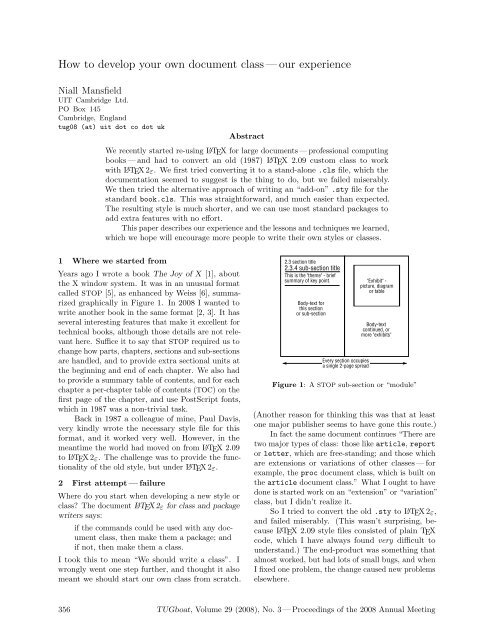The Communications of the TEX Users Group Volume 29 ... - TUG
The Communications of the TEX Users Group Volume 29 ... - TUG
The Communications of the TEX Users Group Volume 29 ... - TUG
Create successful ePaper yourself
Turn your PDF publications into a flip-book with our unique Google optimized e-Paper software.
How to develop your own document class—our experience<br />
Niall Mansfield<br />
UIT Cambridge Ltd.<br />
PO Box 145<br />
Cambridge, England<br />
tug08 (at) uit dot co dot uk<br />
Abstract<br />
We recently started re-using L A<strong>TEX</strong> for large documents — pr<strong>of</strong>essional computing<br />
books—and had to convert an old (1987) L A<strong>TEX</strong> 2.09 custom class to work<br />
with L A<strong>TEX</strong>2ε. We first tried converting it to a stand-alone .cls file, which <strong>the</strong><br />
documentation seemed to suggest is <strong>the</strong> thing to do, but we failed miserably.<br />
We <strong>the</strong>n tried <strong>the</strong> alternative approach <strong>of</strong> writing an “add-on” .sty file for <strong>the</strong><br />
standard book.cls. This was straightforward, and much easier than expected.<br />
<strong>The</strong> resulting style is much shorter, and we can use most standard packages to<br />
add extra features with no effort.<br />
This paper describes our experience and <strong>the</strong> lessons and techniques we learned,<br />
which we hope will encourage more people to write <strong>the</strong>ir own styles or classes.<br />
1 Where we started from<br />
Years ago I wrote a book <strong>The</strong> Joy <strong>of</strong> X [1], about<br />
<strong>the</strong> X window system. It was in an unusual format<br />
called STOP [5], as enhanced by Weiss [6], summarized<br />
graphically in Figure 1. In 2008 I wanted to<br />
write ano<strong>the</strong>r book in <strong>the</strong> same format [2, 3]. It has<br />
several interesting features that make it excellent for<br />
technical books, although those details are not relevant<br />
here. Suffice it to say that STOP required us to<br />
change how parts, chapters, sections and sub-sections<br />
are handled, and to provide extra sectional units at<br />
<strong>the</strong> beginning and end <strong>of</strong> each chapter. We also had<br />
to provide a summary table <strong>of</strong> contents, and for each<br />
chapter a per-chapter table <strong>of</strong> contents (TOC) on <strong>the</strong><br />
first page <strong>of</strong> <strong>the</strong> chapter, and use PostScript fonts,<br />
which in 1987 was a non-trivial task.<br />
Back in 1987 a colleague <strong>of</strong> mine, Paul Davis,<br />
very kindly wrote <strong>the</strong> necessary style file for this<br />
format, and it worked very well. However, in <strong>the</strong><br />
meantime <strong>the</strong> world had moved on from L A<strong>TEX</strong> 2.09<br />
to L A<strong>TEX</strong>2ε. <strong>The</strong> challenge was to provide <strong>the</strong> functionality<br />
<strong>of</strong> <strong>the</strong> old style, but under L A<strong>TEX</strong>2ε.<br />
2 First attempt — failure<br />
Where do you start when developing a new style or<br />
class? <strong>The</strong> document L A<strong>TEX</strong>2ε for class and package<br />
writers says:<br />
if <strong>the</strong> commands could be used with any document<br />
class, <strong>the</strong>n make <strong>the</strong>m a package; and<br />
if not, <strong>the</strong>n make <strong>the</strong>m a class.<br />
I took this to mean “We should write a class”. I<br />
wrongly went one step fur<strong>the</strong>r, and thought it also<br />
meant we should start our own class from scratch.<br />
Figure 1: A STOP sub-section or “module”<br />
(Ano<strong>the</strong>r reason for thinking this was that at least<br />
one major publisher seems to have gone this route.)<br />
In fact <strong>the</strong> same document continues “<strong>The</strong>re are<br />
two major types <strong>of</strong> class: those like article, report<br />
or letter, which are free-standing; and those which<br />
are extensions or variations <strong>of</strong> o<strong>the</strong>r classes—for<br />
example, <strong>the</strong> proc document class, which is built on<br />
<strong>the</strong> article document class.” What I ought to have<br />
done is started work on an “extension” or “variation”<br />
class, but I didn’t realize it.<br />
So I tried to convert <strong>the</strong> old .sty to L A<strong>TEX</strong>2ε,<br />
and failed miserably. (This wasn’t surprising, because<br />
L A<strong>TEX</strong> 2.09 style files consisted <strong>of</strong> plain <strong>TEX</strong><br />
code, which I have always found very difficult to<br />
understand.) <strong>The</strong> end-product was something that<br />
almost worked, but had lots <strong>of</strong> small bugs, and when<br />
I fixed one problem, <strong>the</strong> change caused new problems<br />
elsewhere.<br />
356 <strong>TUG</strong>boat, <strong>Volume</strong> <strong>29</strong> (2008), No. 3 — Proceedings <strong>of</strong> <strong>the</strong> 2008 Annual Meeting

















